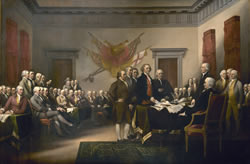U.S. Declaration of Independence
Second Continental Congress
The Declaration of Independence
(1795) by John Trumbull
Chapter 33 of Murray N. Rothbard’s Conceived in Liberty, vol. 4, The Revolutionary War, 1775–1784, presents a valuably historical look at the ratification and declaration of American independence from Great Britain.
The Resolution for Independancy
Also known as the Lee Resolution, this resolution was written by Richard Henry Lee of Virginia and proposed to the Second Continental Congress on 7 June 1776. This resolution was adopted on Tuesday, 2 July 1776, making the American colonies thenceforth officially independent states. While twelve of the thirteen colonies voted yay, New York abstained. The New York Convention approved independence on 9 July 1776.
This is Thomas Jefferson’s original rough draft of the U.S. Declaration of Independence, which was composed in June of 1776. This draft clearly expresses anti-slavery sentiments. Unfortunately, the anti-slavery sentiments were edited out of the final document by the Committee of the Whole, an alteration Jefferson resented severely.
Changes Between the Draft and the Final Copy
While the Committee of Five—Adams, Franklin, Jefferson, Sherman, and Livingston—made some changes to the draft, the most substantive changes were made by the Committee of the Whole. After the Lee Resolution was passed on 2 July 1776, Congress began debating on the language of the Declaration. The main substantive changes were the elimination of Jefferson’s condemnation of slavery and a softening of his sentiments regarding the people of England. This page showcases every alteration made, word by word.
On the night of Thursday, 4 July 1776, after the Second Continental Congress approved the edited Declaration of Independence, John Dunlap of Philadelphia hastily printed the Dunlap Broadsides. John Hancock sent to General Washington one of these copies on 6 July 1776, and Washington ordered that it be read to his troops in New York on 9 July 1776.
On 8 July 1776, John Dunlap printed the Declaration for public consumption in his newspaper, Dunlap’s Pennſylvania Packet, or the General Avertiſer, vol. V, no. 246. This facsimile of the front page of the Packet is from a reprint of the original by J. V. Vondersmith of Philadelphia, published in 1876 on the centennial observance of the Declaration.
The Second Continental Congress ordered on 19 July 1776 that a copy be engrossed on parchment. It was Timothy Matlack whose handwriting appears on this most famous of copies. Contrary to popular opinion, the Declaration was not signed on 4 July 1776. Most historians believe that most of the signers signed on 2 August 1776, with the remaining few signing even later. This copy is now on display at the National Archives in Washington, D.C.
On 18 January 1777, Congress ordered that an “authenticated copy,” including the names of the signers, be sent to each of the thirteen states. This copy, the Goddard Broadside, was printed by Mary Katharine Goddard and was the first printed edition to list the signers.
The spelling in this copy of the Declaration has been altered from the original to reflect modern American English standards. The structure of the document has also been altered to render easier reading.
This page explains in simple words what the Declaration of Independence means, and it contains some fun facts for kids about the Declaration and its signers.
The Declaration of Individualism by Robert LeFevre
This is chapter 14 of This Bread is Mine by the anarcho-pacifist Robert LeFevre. Written in 1960, this work declares individual sovereignty from the state, using language rather similar to that found in the Declaration of Independence.
The Declaration of Independence in American by H. L. Mencken
Written in 1921, this piece provides a highly dumbed-down translation of the Declaration. Warning: this contains some offensive language.
Quotes
The libertarian vision is all in…your Declaration of Independence: We are all created equal; no one ought to have any special rights and privileges in social relations with other men. We have, inherently, certain rights—to our life, to our freedom, to do what we please in order to find happiness. Government has one purpose: to help us protect those rights. And if it doesn’t do that, then it has to go, by any means necessary.
— Brian Doherty, Radicals for Capitalism: A Freewheeling History of the Modern American Libertarian Movement (PublicAffairs, 2007), 21.
The bill of grievances contained in the immortal Declaration of Independence could be extended by our own citizens in modern times, had they the stomach for it. … So important is the right and duty of the people to dispense with despotism, this great Declaration contains the sentence not once, but twice. In its final utterance, the choice of words does not call for the formation of a government. Rather, it calls for “new guards” which may or may not entail such a unit as an artificial agency.
— Robert LeFevre, This Bread is Mine (Milwaukee, Wisconsin: American Liberty Press, 1960), 363, 365.
English barrister John Lind pointed out, with some justice, that the American Declaration of Independence was a formula for anarchy, since every government violated the inalienable rights it listed in some manner.
— Brian Doherty, op. cit., 622, n. 1.
The virtually official reply to the Declaration was written by the barrister John Lind, who largely devoted himself to refuting the “calumnies” against the king. As for the philosophy of the Declaration, Lind thought it sufficient to make the penetrating observation that these doctrines “put the axe to the root of all government,” since every existing or conceivable government alienates some of these supposedly inalienable rights—in short, that the logical conclusion of the natural rights philosophy was anarchism.
— Murray N. Rothbard, Conceived in Liberty, vol. 4, The Revolutionary War, 1775–1784 (1979; Auburn, AL: Ludwig von Mises Institute, 1999), 184.

